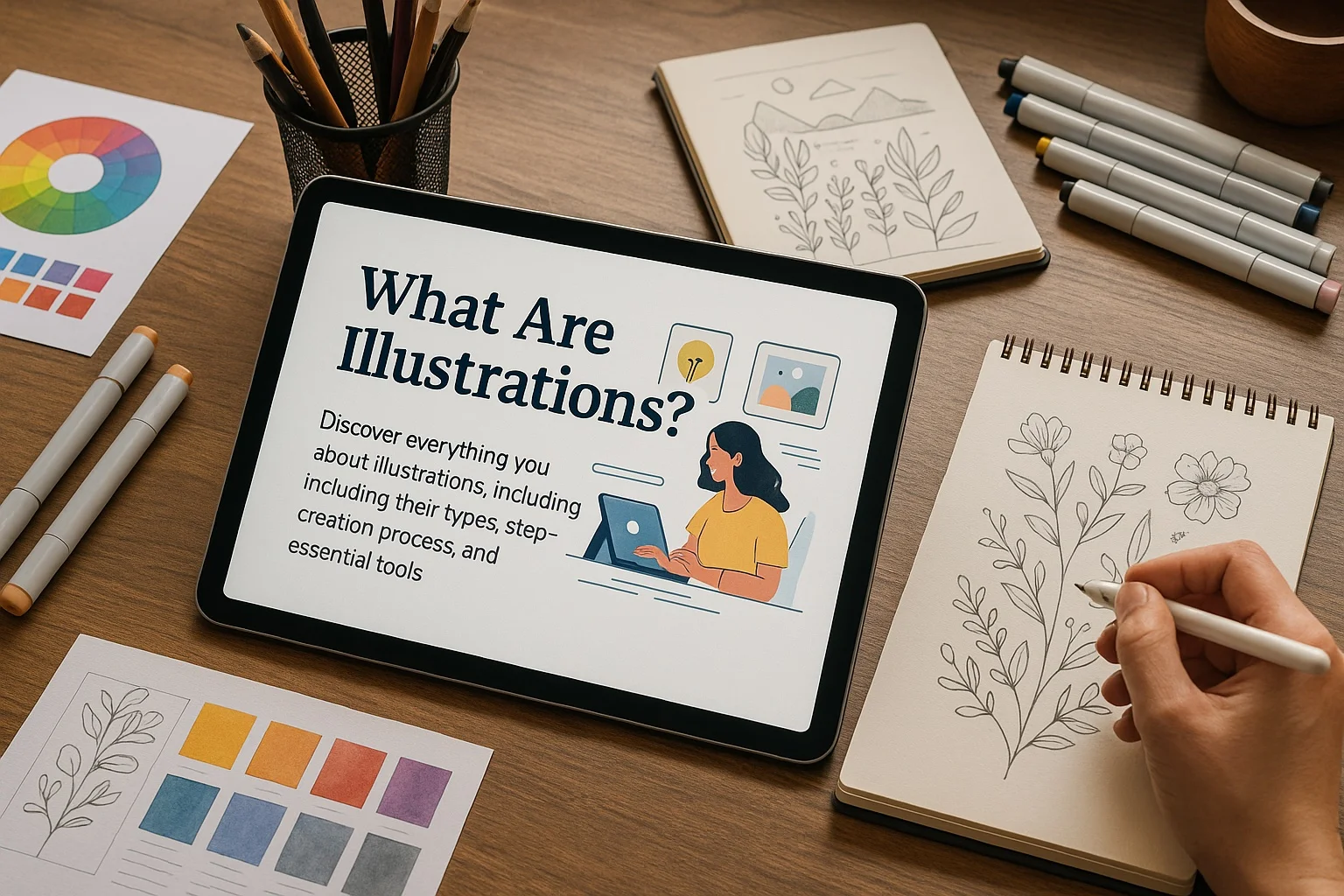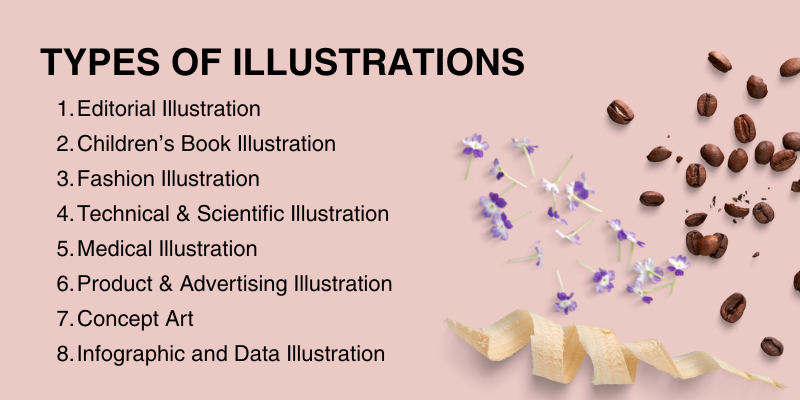In a world overflowing with information, illustrations cut through the noise, speaking to us in ways words alone often can’t.
Whether it's the whimsical charm of a children’s book drawing or the sleek icons guiding us through a website, illustrations influence how we perceive messages, feel emotions, and connect with ideas.
A single well-crafted image can simplify complex concepts, evoke deep emotion, or reinforce brand identity within seconds. They’re an integral part of many creative services used across industries today.
Studies show that visuals improve learning retention by up to 400%, highlighting their power to simplify complex information quickly and effectively.
In marketing, campaigns with strong visual elements generate 94% more views and engagement, highlighting the role of illustrations in capturing attention and fostering connection.
This makes them indispensable in creative campaign services aimed at increasing brand visibility and emotional resonance.
What are Illustrations? It is a purposeful visual designed to communicate specific ideas or stories, making it essential in various fields.
Illustrations have been a key aspect of human expression for millennia, evolving from ancient cave paintings to sophisticated digital art.
Now, they permeate every aspect of our lives, enhancing books, animating films, personalizing brand identities, and making educational content more accessible.
In this blog, we will explore the various types of illustrations, applications, and tools illustrators use and examine how illustration continues to transform storytelling in the digital era.
We’ll also answer questions like what is an illustration and provide illustration examples to showcase their impact.
Whether you’re a designer, educator, or simply curious, understanding what does illustration means will deepen your appreciation for its unique ability to inform, inspire, and captivate.
What Are Illustrations?
An illustration is a visual representation created to enhance, clarify, or complement a concept, idea, or story. Unlike random drawings or casual sketches, illustrations are purposeful.
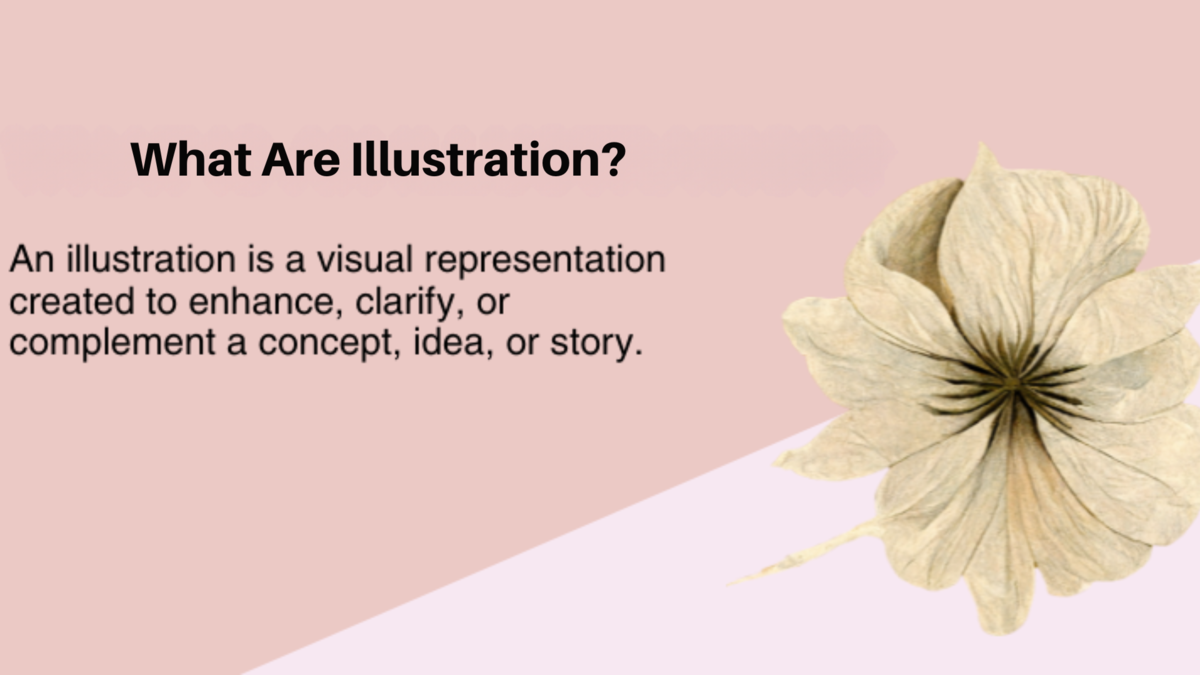
They serve a clear function: to communicate something specific, whether it’s an emotion, instruction, or narrative. What is an illustration? It is art with intent, crafted to convey a message effectively.
At its core, illustration is art with intent. While both a sketch and an illustration may use similar tools—pencil, ink, digital brushes—the difference lies in the outcome. A sketch might simply explore form or express an idea informally.
An illustration, on the other hand, is crafted to serve a communicative role, often tied directly to accompanying content such as text, products, or user interfaces or customer portal development features.
Illustrations can be literal or abstract, realistic or stylized, depending on their context and message. This adaptability makes them ideal for aligning with branding guidelines in marketing and design projects.
For example, a botanical illustration is a classic illustration example that aims for scientific accuracy to aid plant identification, while a comic book illustration may exaggerate features for storytelling effect.
These are great illustration examples that highlight what does illustration achieve in different contexts.
Their purposes are diverse:
- To explain a process (as in medical or technical illustrations)
- To decorate a page or product (like in packaging or editorial design)
- To interpret emotions or stories (seen in children’s books or concept art)
Illustrations are tailored to their audience and medium, making them highly versatile across industries.
From print to digital, educational to commercial, illustration remains an essential tool for visual storytelling, transforming abstract concepts into understandable, relatable, and often beautiful images.
Understanding what is an illustration helps appreciate its role in communication.
What Does An Illustrator Do?
An illustrator is a skilled artist who creates visual representations to communicate ideas, stories, or concepts. They use various tools ranging from traditional mediums like pencils and paints to digital software like Adobe Illustrator or Procreate to craft images that enhance narratives, advertise products, or engage audiences. Illustrators work across diverse industries, including publishing, advertising, gaming, and film, collaborating with clients or creative teams to bring visions to life. Their tasks may include sketching storyboards, designing characters, creating editorial illustrations for magazines, or producing visuals for branding campaigns. By combining creativity with technical expertise, illustrators translate abstract ideas into compelling visuals that resonate with viewers.
8 Types Of Illustrations
What are Illustrations? They come in many forms, each tailored to serve a unique purpose across different industries. Below, we explore key types of illustrations that demonstrate their versatility.
1. Editorial Illustration (used in articles, newspapers)
Editorial illustrations are used to enhance written content in magazines, newspapers, blogs, and online publications. Their purpose is to visually represent the article’s core message, often using metaphor, symbolism, or humor to offer a deeper understanding or provoke thought.
For example, The New Yorker’s clever editorial illustrations are a prime illustration example that accompanies political or social commentary, helping readers engage with complex topics through creative imagery.
2. Children’s Book Illustration
Children’s book illustrations are designed to bring stories to life for young readers, often making the narrative more engaging, accessible, and imaginative.
These illustrations use vibrant colors, expressive characters, and whimsical scenes to stimulate imagination and aid comprehension. They are central to content creation in children’s publishing, transforming words into memorable visual narratives. As businesses focus on establishing a unique brand identity, digital branding services are becoming increasingly important.
They help companies craft consistent and visually appealing illustrations that align with their overall branding strategy, ensuring a seamless brand presence across all platforms and media. Quentin Blake’s playful, sketchy style in Roald Dahl’s books is a classic illustration example of this type.
3. Fashion Illustration
Fashion illustrations are stylized visual representations of clothing, accessories, and runway concepts, often used in the early stages of fashion design.
They capture the mood, movement, and texture of garments in an artistic way. For instance, David Downton’s portraits of haute couture designs, featured in Vogue and Harper’s Bazaar, are iconic illustration examples showcasing elegance and flair through expressive linework.
4. Technical & Scientific Illustration
Technical and scientific illustrations are highly detailed and accurate visuals used to explain mechanical systems, scientific concepts, or engineering designs.
These illustrations are crucial in fields like aerospace, engineering, and biology. Automotive manuals with exploded engine diagrams are a practical illustration example, essential for education and troubleshooting.
They are also used extensively by an automotive marketing agency to communicate technical features visually while maintaining brand aesthetics.
5. Medical Illustration
Medical illustrations are precise, anatomical drawings used in textbooks, surgical guides, and educational material to visualize the human body and medical procedures.
These are often created by professionals with dual expertise in art and medical science. A notable example is the Gray’s Anatomy textbook, which uses detailed illustrations to teach generations of medical students about human anatomy.
6. Product and Advertising Illustration
Product and advertising illustrations are used to market goods and services by making them visually appealing and memorable. These illustrations may be realistic or stylized depending on the brand identity.
Think of Coca-Cola’s iconic holiday ads featuring Santa Claus, originally illustrated by Haddon Sundblom. These illustrations became a central part of the brand’s visual storytelling and seasonal campaigns.
7. Concept Art
Concept art is used primarily in the entertainment industry to visualize ideas for films, video games, animation, and more before the final product is created. It helps directors, developers, and designers explore characters, environments, and moods.
Ralph McQuarrie’s concept art for Star Wars, shaping characters like Darth Vader and settings like Cloud City, is a renowned illustration example. Such illustrations serve as the backbone for the development of iconic visuals and designs, making them integral in early creative stages.
When paired with website design services, concept art can also be used to inspire the aesthetics of websites, creating unique, immersive digital experiences for visitors.
8. Infographic and Data Illustration
Infographics and data illustrations are created to present complex data or information in a visual, easy-to-understand format.
These illustrations combine charts, icons, symbols, and concise text to help readers quickly grasp key insights.
For businesses offering b2b web design and development services, using well-crafted infographics can enhance website engagement by simplifying complex information for potential clients.
A real-world example is National Geographic’s infographics, which often break down scientific or geographical data into beautifully illustrated, digestible visuals that appeal to both casual readers and experts alike.
What Are The Purpose And Uses Of Illustrations?
Illustrations serve a wide range of purposes across industries, acting as powerful tools to inform, engage, persuade, and entertain. Their versatility makes them essential in both traditional and digital media.
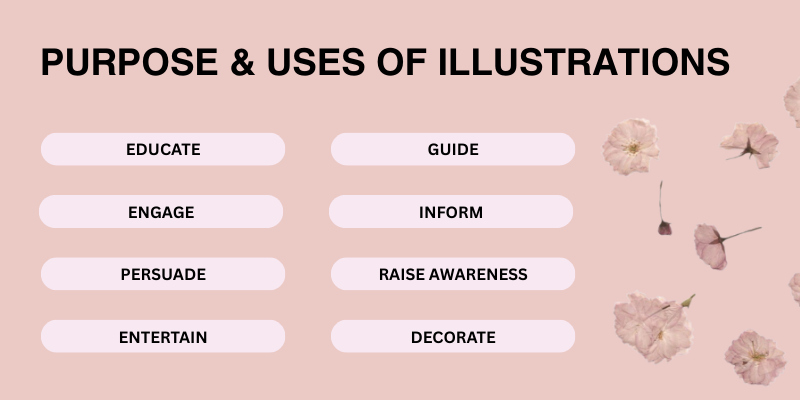
- Educate: Simplify complex concepts for better understanding and retention, such as explaining features during product launches.
- Engage: Capture attention and evoke emotions.
- Persuade: Strengthen brand identity and influence decisions, often supported by design retainers to maintain consistent creative output.
- Entertain: Bring stories and characters to life in media and games.
- Guide: Improve navigation and user experience in digital interfaces, especially after a thorough UI UX audit.
- Inform: Visualize data and scientific information clearly.
- Raise Awareness: Communicate social and environmental issues effectively.
- Decorate: Enhance aesthetics in publishing, advertising, and products.
Illustrations remain a versatile and powerful medium across industries, transforming ideas into compelling visuals that connect with audiences on multiple levels.
The Process of Creating Illustrations: From Idea to Finalization
Creating a successful illustration starts with a clear definition of the main idea. Here are the steps involved in creating illustrations:
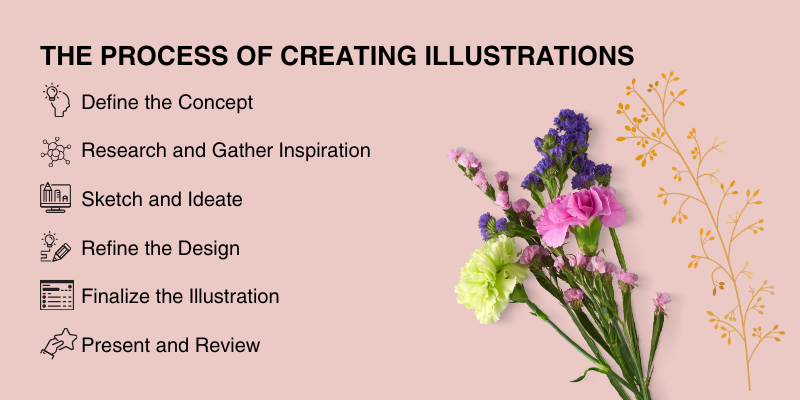
1. Define the Concept:
Start by clearly understanding and defining the main idea or message the illustration should convey. This step answers “what is an illustration” by ensuring the artwork aligns with the project goals and communicates the intended story effectively.
2. Research and Gather Inspiration:
Immerse yourself in the subject matter. Collect references, create mood boards, and study related visuals to inform the style, tone, and content of your illustration.
3. Sketch and Ideate:
Begin with quick, rough sketches to explore different compositions and ideas. This phase is about experimentation and finding the strongest visual approach.
4. Refine the Design:
Select the best sketch and develop it further. Decide on details like layout, color palette, and style. Create more polished, colored drafts to solidify your concept.
5. Finalize the Illustration:
Execute the final artwork according to technical specifications. What is digital illustration? It’s the process of creating scalable, high-quality digital artwork using tools like Adobe Illustrator or Procreate, as described earlier. Start with basic shapes, gradually adding textures, shading, and fine details. Ensure balance and color harmony.
6. Present and Review:
Share the finished illustration with clients or stakeholders through mockups or previews. Gather feedback and make adjustments if necessary to achieve approval.
Following this structured process helps create clear, effective, and visually compelling illustrations while allowing room for creativity and iteration.
Illustration vs Photography vs Graphic Design
What are Illustrations? They are one of several powerful tools in visual communication, alongside photography and graphic design, each with unique strengths and ideal use cases.
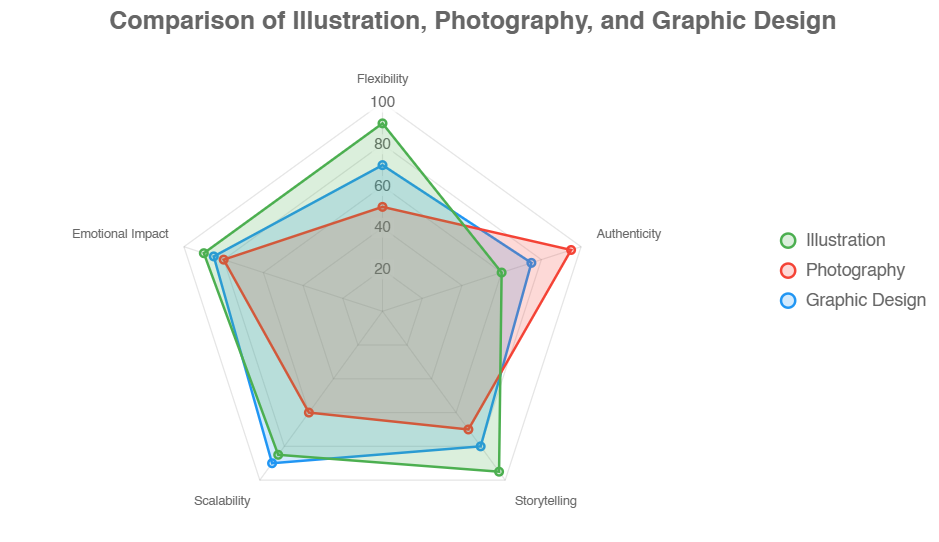 Illustration offers unmatched flexibility, allowing creators to visualize abstract ideas, emotions, and concepts that may not exist in the real world.
Illustration offers unmatched flexibility, allowing creators to visualize abstract ideas, emotions, and concepts that may not exist in the real world.
It’s often preferred when storytelling requires imagination or metaphor, such as in children’s books, editorial cartoons, or conceptual branding.
In contrast, photography captures real moments, people, and environments. It excels in conveying authenticity and relatability, making it ideal for lifestyle brands, product showcases, and documentary-style content. However, it is limited by what can be physically photographed and may lack the flexibility that illustrations offer for surreal or symbolic visuals.
Graphic design acts as the framework that brings everything together, combining typography, imagery (including both photos and illustrations), layout, and color to communicate a message effectively. It’s used across websites, packaging, advertising, and branding, ensuring that all visual elements are cohesive and functional.
Here’s a list of common tools used to create illustrations, with explanations for each:
1. Traditional Tools
- Pencils: Pencils are fundamental for sketching and drafting ideas. They allow artists to quickly explore shapes, compositions, and details with precision. Pencils come in various hardness grades, enabling light sketches or bold lines, making them versatile for initial concept development.
- Ink: Ink provides strong, permanent lines that bring clarity and contrast to illustrations. Often used for outlining or adding details, ink can be applied with pens, brushes, or nibs. Its boldness makes it popular in comic art, editorial illustrations, and graphic novels.
- Watercolor: Watercolor paints offer soft, translucent color layers that create depth and atmosphere. Known for their fluidity and unpredictability, watercolors are often used to add emotion and texture to illustrations, especially in children’s books and fine art.
2. Digital Tools
- Adobe Illustrator: A leading vector graphics software, Adobe Illustrator allows artists to create scalable artwork using paths and shapes. It’s ideal for logos, icons, and clean, sharp illustrations that require resizing without quality loss.
- Procreate: Procreate is a powerful digital painting app designed for iPads, featuring a wide range of customizable brushes and a user-friendly interface. It provides a natural drawing experience, favored by many illustrators for creating detailed and expressive digital artwork.
- Adobe Photoshop: Photoshop is a raster-based program perfect for detailed digital painting, photo editing, and texturing. It supports complex layering and effects, making it suitable for realistic or highly detailed illustrations.
3. 3D Illustration Tools
- Blender: Blender is a free, open-source 3D modeling and rendering software. It allows artists to create three-dimensional illustrations, animations, and visual effects, adding depth and realism or stylized 3D elements to their work.
- Cinema 4D: Cinema 4D is a professional 3D software popular in motion graphics and advertising. It offers powerful tools for modeling, texturing, and animating, enabling illustrators to create visuals adaptable for UI UX audit improvements, offline print designs, and dynamic digital marketing campaigns.
Future Trends in Illustration
Here are five emerging illustration trends shaping the creative landscape:
- Eco-Conscious Imagery: Illustrations reflecting environmental awareness, featuring earthy tones and nature-inspired elements, are gaining popularity as sustainability becomes a central theme in design.
- Retro-Futurism: A blend of nostalgic design elements with futuristic concepts, retro-futurism combines bold colors and geometric shapes to evoke a sense of both past and future.
- Minimalist Line Art: Simplified designs using delicate lines and limited color palettes offer a clean and sophisticated aesthetic, emphasizing clarity and elegance.
- Inclusive Representation: Illustrations showcasing diverse characters and scenarios promote inclusivity, reflecting a broader range of identities and experiences in visual storytelling.
- Playful 3D Illustrations: Incorporating three-dimensional elements with a whimsical touch, playful 3D illustrations add depth and engagement, moving beyond traditional flat designs.
These trends highlight the evolving nature of illustration, embracing both technological advancements and a deeper connection to cultural and social narratives. For businesses looking to enhance their online presence, incorporating these trends into their digital content can also complement e-commerce SEO services by improving user engagement and making websites more visually appealing to potential customers.
Why Businesses Are Increasingly Integrating Illustrations?
Illustrations help businesses stand out by creating unique, memorable visuals that communicate complex ideas quickly and clearly.
Unlike stock photos, custom illustrations offer originality and flexibility, allowing brands to convey their personality and values more effectively. Brand marketing services providers and creative services providers play a key role in developing these tailored visuals, ensuring that businesses can integrate illustrations into their branding and marketing efforts.
Illustrations are also highly versatile; they can be used across websites, social media, packaging, advertising, and presentations to enhance storytelling and improve engagement. They make messages more relatable and emotionally appealing, which helps build trust and loyalty among consumers.
Moreover, with the rise of digital marketing services, businesses need visuals that work well on multiple platforms and devices.
FAQS About What Are Illustrations?
What are Illustrations in Art?
Illustrations are purposeful visual representations created to clarify or enhance ideas, stories, or concepts. Unlike casual sketches, they communicate specific messages and emotions, appearing in forms like drawings, paintings, or digital art. For example, a botanical drawing in a scientific journal illustrates both artistic skill and scientific accuracy.
What is a list of illustrations?
A list of illustrations is an index in books or reports that catalogs all visuals, including figure numbers, titles, and page references. For example: “Figure 1: Anatomical Diagram of the Heart, p. 23.” It helps readers quickly locate diagrams, infographics, or technical drawings.
What are the four basics of illustration?
The basics of creating effective illustrations are:
-
Concept Definition – Clarify the message or idea.
-
Research & Inspiration – Collect references to guide style.
-
Sketching & Ideation – Explore rough drafts and compositions.
-
Refinement & Finalization – Develop a polished artwork, often using tools like Adobe Illustrator.
What does an illustration look like?
Illustrations vary by purpose and style: they can be realistic (e.g., medical drawings in Gray’s Anatomy) or stylized (e.g., children’s book characters). They may be hand-drawn, painted, or digitally designed with tools like Procreate. For instance, a fashion sketch in Vogue conveys style, while an app icon illustration emphasizes simplicity and function.
Conclusion
Illustrations are more than just pictures; they are powerful tools that help us understand and connect with the world around us.
By transforming complex ideas into visual forms, illustrations make information easier to grasp and more engaging.
Whether it’s a diagram in a textbook, a character in a children’s story, or an icon on a website, illustrations play a vital role in communication.
Throughout history, illustrations have evolved alongside advancements in technology and culture. From ancient cave paintings to modern digital illustration, they have adapted to meet the needs of their time.
Today, illustrations continue to thrive in various fields, including education, marketing, entertainment, and digital media.
Their ability to convey emotions, simplify complex concepts, and capture attention ensures that illustrations remain an essential part of storytelling and communication.
As we move forward, the creative possibilities for illustrations are limitless, promising even more innovative and impactful ways to connect with audiences.
